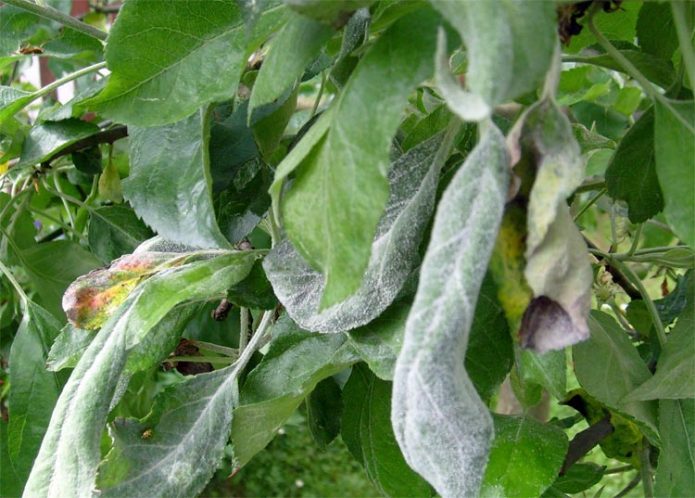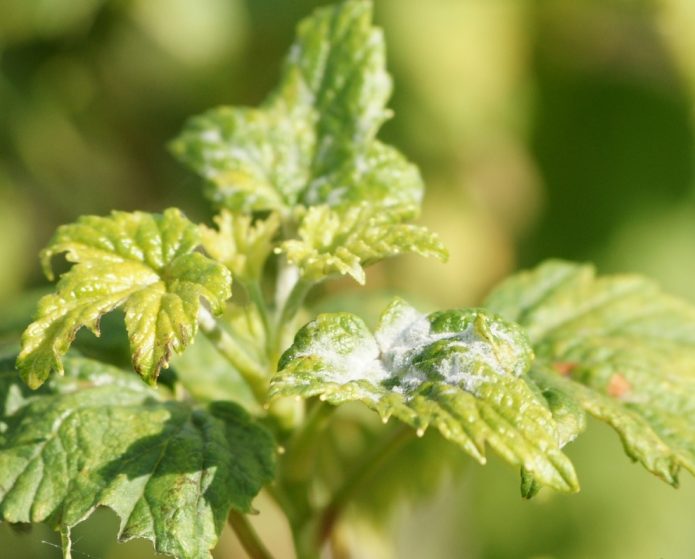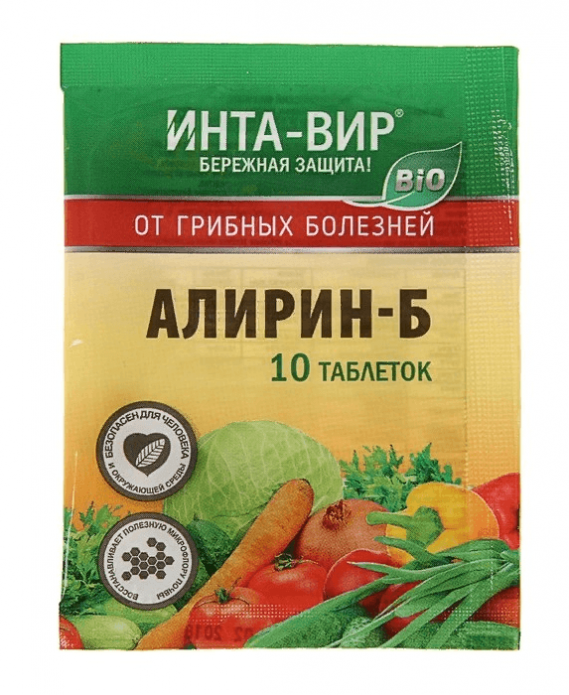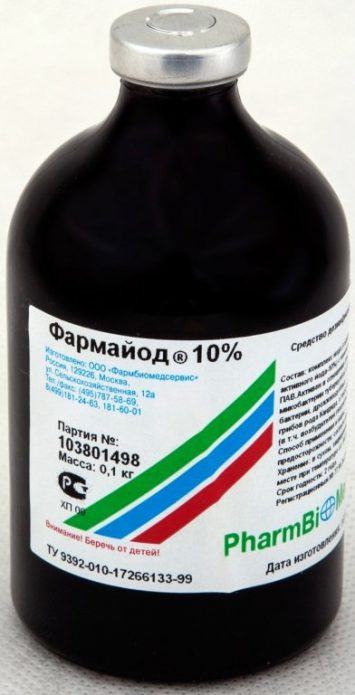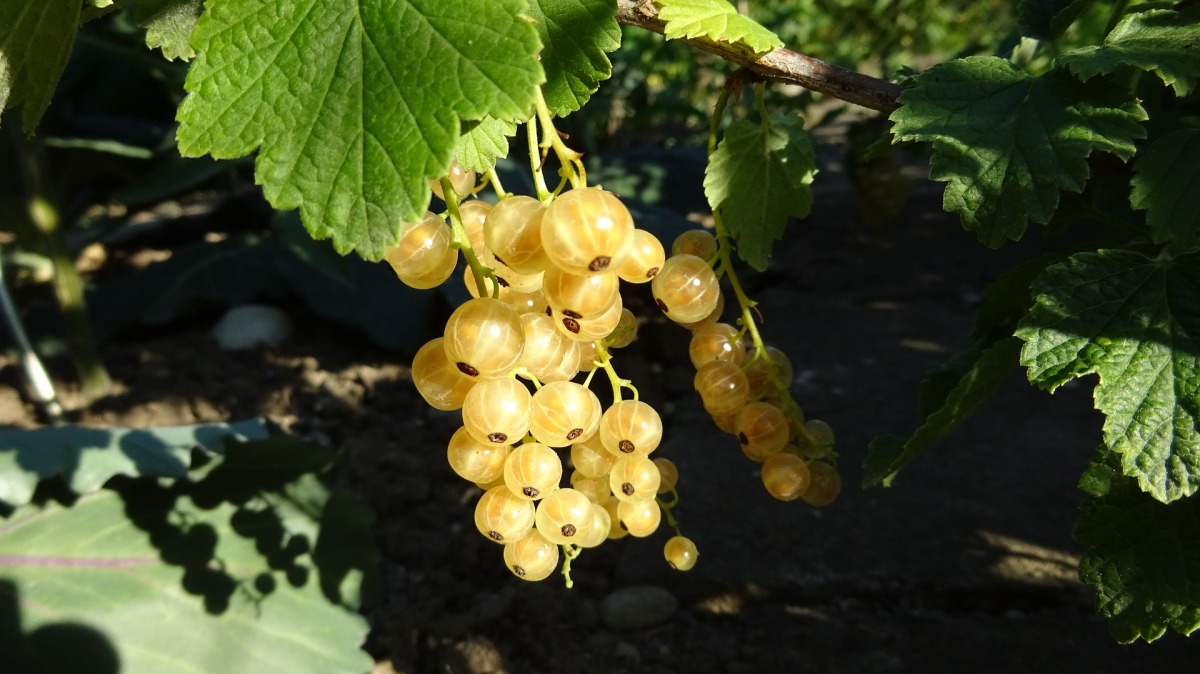Powdery mildew is a disease that affects crops on the ground, shrubs and trees. The crop can die if you do not take measures to get rid of it, or even better, timely prevention.
Content
What is powdery mildew
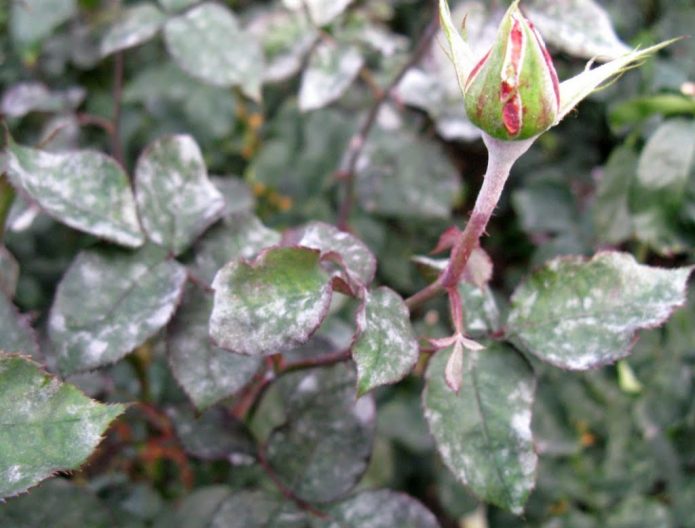
As a result of the settlement of powdery mildew on roses, they lose their decorative appearance and stop growing, the buds are deformed and do not open, and the leaves of the plant turn brown, blacken and dry out
Powdery mildew is a fungus that infects plants. A light white (sometimes grayish) coating appears on top of the leaves, similar to dust. It then spreads to shoots, flowers and fruits. On this plaque, drops of liquid are formed, because of which the name arose. Then brown spots appear on the surface. Gradually, the entire surface darkens.
The fungus is a parasite, it feeds on plant juices. In addition, the areas covered by it do not participate in photosynthesis. Therefore, crops affected by powdery mildew weaken. Leaves and shoots gradually die off, and ovaries do not form on the inflorescences. Reduces resistance to cold. Because of this, the plant may even die.
Leaves close to the ground are affected first. Spores are spread by water, air, tools or hands. Plants weakened by pruning or improper care are more quickly affected.
Powdery mildew is found on different types of crops, with a separate type of fungus parasitizing each. Garden trees are more likely to suffer:
- Apple tree;
- cherry;
- quince;
- plum;
- pear;
- apricot;
- cherries.
Shrubs most susceptible to powdery mildew:
- gooseberry;
- grapes;
- currant;
- lilac;
- honeysuckle;
- rosehip;
- almond;
- barberry;
- hazelnut;
- raspberries.
Of the vegetables, the most defenseless against powdery mildew are:
- zucchini;
- cucumbers;
- bow;
- pepper;
- cabbage;
- potatoes;
- tomatoes;
- beet;
- garlic;
- pumpkin.
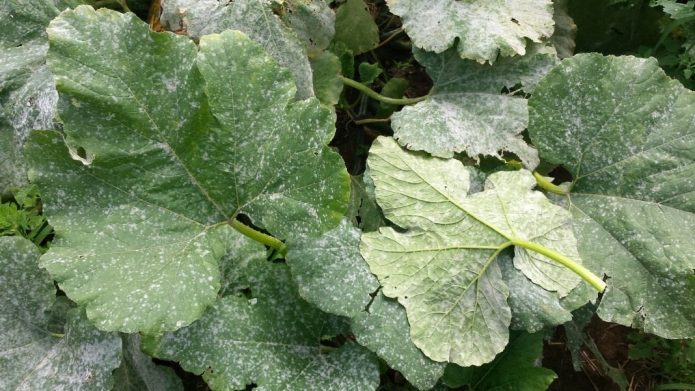
Such a defeat is already considered serious: in such cases, after harvesting, experts recommend destroying all plant residues
Ornamental plants also suffer from this fungus, especially:
- asters;
- gerberas;
- dahlias;
- chrysanthemums;
- delphiniums;
- roses;
- petunias;
- daisies;
- marigold;
- calendula.
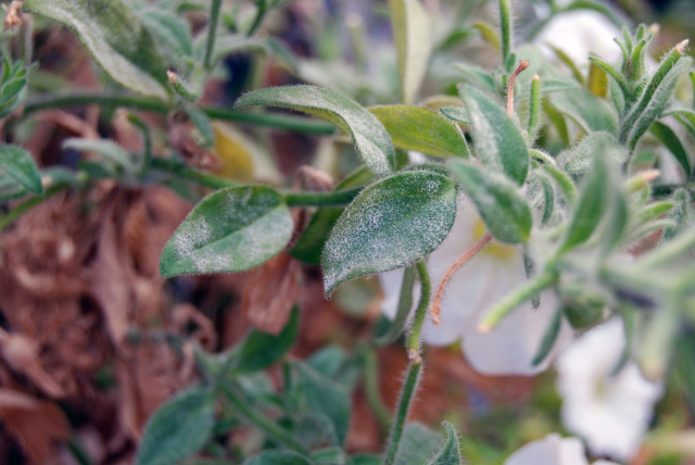
If you look closely, on the leaf plates where the mycelium has attached, you can see tiny sores, because of which the petunia withers more and more every day
Indoor plants are also affected by this disease, such as:
- dracaena;
- rose flower;
- orchid;
- Kalanchoe;
- Saintpaulia (violet);
- yucca;
- ficus.
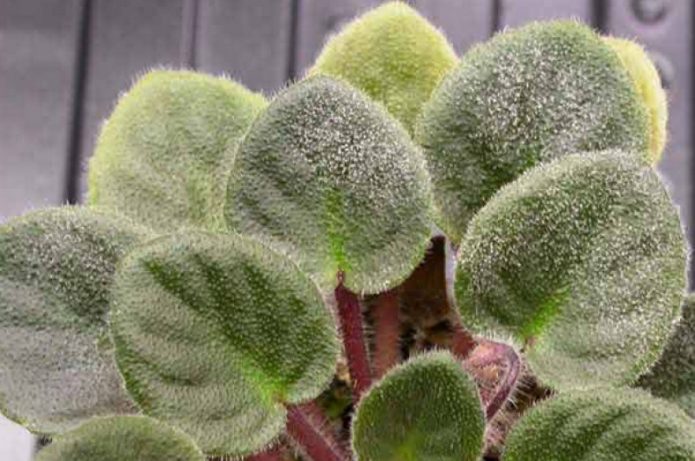
The most common conditions for the appearance of fungus on violet leaves are excessive watering, poor lighting and low air temperature.
How to distinguish true from false: examples in the photo
Downy mildew is also a fungal disease. But it is caused by a fungus from another family. Outwardly, it differs in the location of a whitish bloom."True" powdery mildew appears on the top of the leaves, and false - on the inside.

Another name for downy mildew, often found in the instructions for the drug from it, is peronosporosis
Yellow spots appear on top of the leaves. Various means are used to combat these diseases. Therefore, before starting treatment, it is important to carefully consider the leaves and determine which of these species you have to deal with.
Chemicals
Means for powdery mildew are divided into two types:
- fungicides (Topaz, Raek, Skor);
- biofungicides (Fitosporin).
The first of them are chemicals that are more effective, but are moderately hazardous to humans (3rd class of toxicity).
Do not treat plants with fungicides if 20 days or less are left before harvest.
Biofungicides are cultures of living beneficial bacteria or saprophytic fungi (“eating” bioorganisms) that prevent the spread of diseases.
Bright sunlight is detrimental to biofungicides, so you need to process the garden and vegetable garden with them in the evening or in cloudy weather.
These drugs belong to the 4th class of toxicity. This means that they can cause a slight burning sensation in the mucous membrane, but are otherwise not dangerous.
Plants can be treated with them before planting, during growth and even before harvesting.
All chemicals are diluted with water to the desired concentration. The plants are then sprayed abundantly. The liquid should drain from them, as after a heavy rain. If necessary, the processing is repeated. It is undesirable to use the same agent (active ingredient) more than 3-4 times. Otherwise, efficiency is lost, as the fungus adapts to the fungicide. Precautions must be taken. Keep drugs away from children and animals. Dilute only in non-food containers, and wear gloves when processing, do not eat or smoke.
"Topaz"
The active ingredient of this drug is penconazole. The tool is available in the form:
- ampoules for 2 ml;
- 10 ml vials;
- containers for 1 liter.
It can be stored in a closed package for 4 years, after which it cannot be used.
Before use, the drug is diluted. For vegetables and horticultural crops, 2 ml requires 10 liters of water, and for flowers - 2.5 liters. First, add the emulsion to a small amount of water and mix thoroughly, and then add the rest. You cannot use food utensils for this. Processing is carried out 3-4 times with a break of 1-2 weeks. The weather should be dry and calm, then the drug works most effectively.
"Paradise"
The drug is based on difenoconazole. Produced in the form:
- ampoules for 2 ml;
- vials of 10, 50 or 100 ml;
- containers of 1 liter.
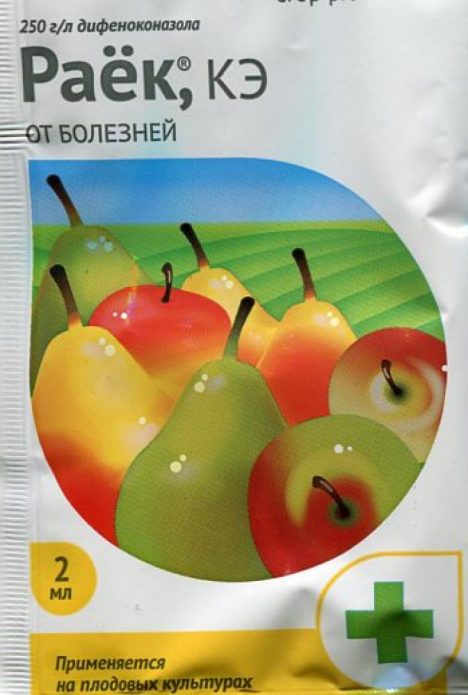
It is not worth storing a solution of a chemical preparation - it is better to initially calculate its dose so that it is all consumed at a time
The emulsion is diluted with water. The method is the same as for Topaz: 2 ml per 10 liters of water for fruit trees and 4 ml per 5 liters for vegetables. Penetrates into plants within two hours, after this time the rain is not terrible. The treatment is carried out 3-4 times. During treatment, breaks are made in 7-10 days, for prevention - 10-15. Treatment is most effective if the first application is not later than 4 days from the onset of the disease.
The agent can be mixed with others (for example, for complex prevention). It is added to the solution last.
"Speed"
This is an analogue of the fungicide "Raek" with the same active ingredient (difenoconazole) and release forms.
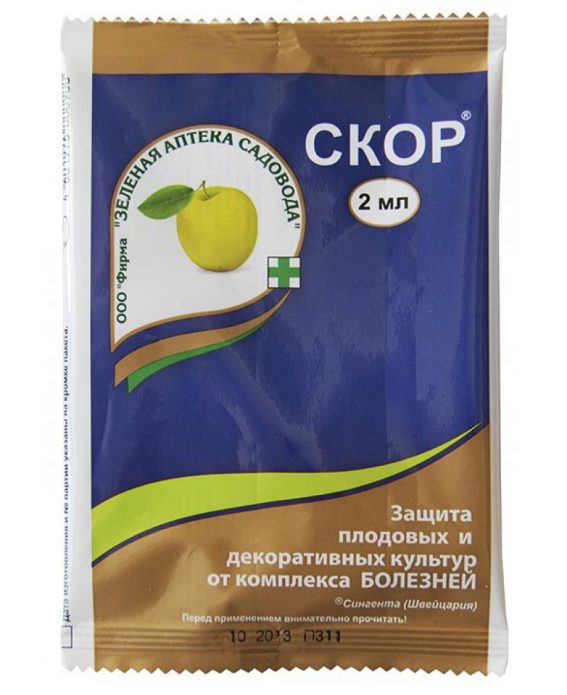
When using large vials of drugs for the correct dosage, it is very convenient to use a medical syringe
In addition to direct protection against pathogenic fungi, the use of Skor allows:
- increase bushiness, shoot length, number and size of leaves of crops by one and a half times due to the general strengthening of their immunity;
- to increase the period of preservation of the green surface of plants, as a result of which the processes of photosynthesis are better and longer and, accordingly, the yield increases;
- accelerate seed germination (for example, for vegetables - by an average of two days), as well as improve their germination;
- increase the shelf life of seeds.
Diluted at a concentration of 2 ml per 10 liters of water. In this form, the solution is stored for up to 3 weeks. 3-4 treatments are carried out, for diseased plants after 4-5 days, and for healthy ones - after 10-12.
Fitosporin
This is a biofungicide, that is, a preparation based on beneficial bacteria - hay bacillus (Bacillus subtilis). Release forms:
- powder (10 g and 30 g);
- pasta (200 g);
- suspension (liquid) in vials.

"Fitosporin" is often mixed with humates and acts simultaneously as a fungicide and fertilizer, especially when spraying at the correct (evening) time
Produced universal "Fitosporin-M" and special for individual crops (for example, for tomatoes and cucumbers). In the latter, trace elements are added that are useful for a particular plant. Thanks to this feeding, powdery mildew is easier to tolerate.
The drug dissolves in water at a concentration depending on the form of release:
- 100 g of paste is diluted in 200 ml of water, in this form "Fitosporin" can be stored, and before spraying 3 tsp. dilute with 10 liters of water;
- the powder is diluted as follows: 10 g per 5 l of water (reprocessing is carried out after 2-3 weeks);
- liquid solution - 10 drops per 200 ml.
"Trichodermin"
Biological preparation based on trichoderma lignorium fungi (contains spores and mycelium). Available in two forms:
- powder (200 g per 10 l of water);
- liquid (200 ml per 10 l).
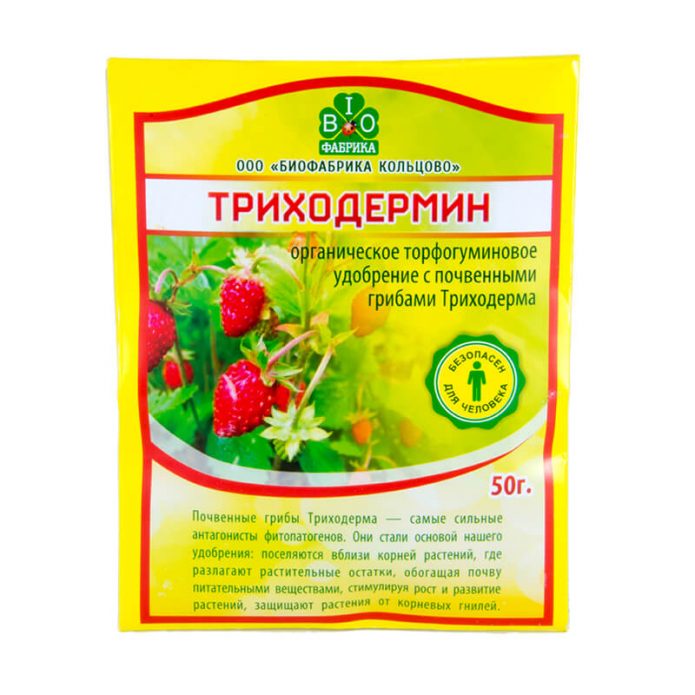
The Trichoderma lignorum fungus enriches the soil, accelerating the decomposition of organic matter in it, and the bioactive substances released by the fungus promote fruit growth and protect plants from various diseases
Effective within 25-30 days after treatment. Then it can be repeated.
"Alirin-B"
Produced in the form:
- tablets - from 2 to 10 tablets, depending on the degree of plant damage, dissolve in 10 liters of water;
- dry powder;
- liquids.
Dry powder and liquid are used on the farm, and tablets are intended for summer residents and gardeners. When dissolved in water, it is important to add green soap or other "adhesive". Plants are re-treated with this preparation in 1-2 weeks.
"Pharmayod"
It is an iodine-based antiseptic preparation. Available in containers of 80 and 800 ml and 5 liters. Stored unopened for 5 years from the date of issue.
Spraying with this fungicide should be carried out with a mask and rubber gloves.
Spraying requires 3-5 ml of "Farmayoda" and 10 liters of water. The product must be used on the same day. Better to spray them immediately. Processing is carried out once.
Comparison table of prices: for a note to the gardener
| Name | Release form | Average price (rub.) |
| "Topaz" | ampoule 2 ml | 34 |
| "Paradise" | ampoule 2 ml | 27 |
| "Speed" | ampoule 2 ml | 54 |
| "Alirin-B" | 20 tablets | 74 |
| Fitosporin | bottle 110 ml; pasta 200 g | 80; 69 |
| "Trichodermin" | 50 g; 0.8 l | 350; 1050 |
| "Pharmayod" | 0.95 ml. | 199 |
Folk remedies for processing
Such remedies do not harm the plants, but are less effective during illness. Therefore, folk recipes are suitable for the prevention or onset of infection. Prevention is carried out at least three times per season: at the beginning, middle and end.
Soda
Dilute 50 g of soda ash or ordinary baking soda in 10 liters of water. Add 10 g of any liquid soap (if it is not available, laundry soap will do). The plants should be sprayed with this mixture twice: before and after flowering.
Iodine
Add 10 ml of alcoholic tincture of iodine to 10 liters of water. For roses and indoor plants, the ratio is different: 20 ml of iodine per 7 liters of water.
Ash
Pour 300 g of wood ash into 1 liter of water and bring to a boil. After this mixture has cooled, strain through a cloth or cheesecloth. Spray 3-4 times, with a break of 3-5 days.
Manure
Fresh manure, preferably cow manure, pour water in a ratio of 1: 3 and leave for 3 days. Strain thoroughly and dilute with water again in a ratio of 1:10. Treat 2-3 times with an interval of 7-10 days.
Weeds
Finely chop the weed grass and cover with hot water (of the same volume).Insist for several days, strain through cheesecloth. Process at least 3 times with a break of about a week.
Milk serum
Separate the whey from any spoiled fermented milk products. Dilute 1:10 with cold water and mix thoroughly. Spray at least 3 times, with a break of 3 days.
Disease control measures depending on the type of plant
The treatment of plants from powdery mildew is carried out according to similar principles. But there are also some peculiarities associated with the type and place of growing plants.
- In bushy species such as currants, gooseberries, raspberries, etc., it is useful to prune off damaged shoots as much as possible. For prevention in early spring, even before bud break, they are poured with boiling water.
This does not harm the bushes, but kills spores. - It is important for trees to thin out the crowns and remove the leaves in a timely manner.
They contain spores that infect the trees the next year. It is useful to mulch the soil with wood chips or bark. - From crops growing on the ground (vegetables and herbaceous flowers, including cucumbers, strawberries, tomatoes), leaves that touch the ground are removed.
- This must be done even before the defeat, in order to prevent. And the beds are thinned out so that the plants do not touch each other. If vegetables are grown in greenhouses or hotbeds, they must be washed and disinfected after harvest.
- For flowers and indoor plants (petunias, roses, etc.), some preparations are diluted in a higher concentration (this is indicated in the instructions). For potted flowers, it is advisable to replace the topsoil. It is useful not only to spray them, but to put them entirely in a container with a powdery mildew remedy.
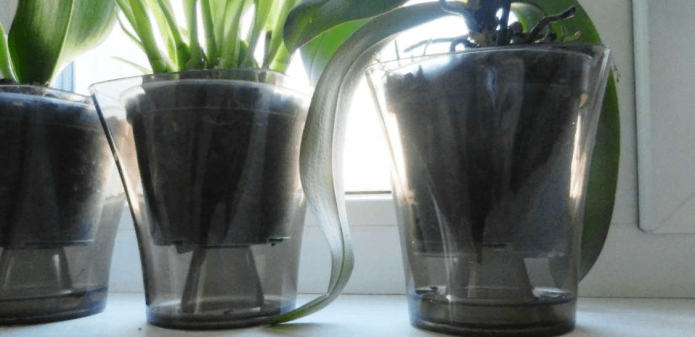
These pots, not necessarily transparent, will be ideal containers for additional treatment of potted plants from powdery mildew.
Reviews on the effectiveness of store and home remedies
Dissolve ordinary household soap in water, soak a cotton swab in it and wipe the plant. The next day can be repeated. I did it with primrose. Two times was enough.
Powdery mildew, in my opinion, appears if the plant is not ventilated, dense plantings. It is necessary to thin out the bush itself. Skor and Topaz are very helpful on currants.
Two days ago I had to try iodine tincture from powdery mildew. I was very afraid to burn the leaves, so I processed only those rosettes where I saw a plaque. I didn't remove flowers on blooming flowers, it's a pity. Yes, and it was interesting to see if they deteriorate, they will not deteriorate. Today, all processed sockets are clean, without plaque. Not burnt, and even with flowers! (even white-flowered). I removed only a couple of flowers from those that had already started to wither by the time of processing.
Folk remedy, you'll laugh: slurry. The effect is amazing. But, for obvious reasons, application is not possible everywhere. Water the affected plant, rinse with water the next day. As for concentration, I won't say for sure, but the color of this case is, say, like strong tea. Maybe someone who used it will tell you more precisely. I am only an eyewitness.
Powdery mildew appears as a white bloom that darkens when the spores mature. To combat it, there are a number of chemicals, as well as folk remedies. Work to get rid of the misfortune should start as early as possible - in this case, the forecast will be positive: most likely, it will be possible to quickly get rid of the fungus, and the plant will be maximally preserved.
